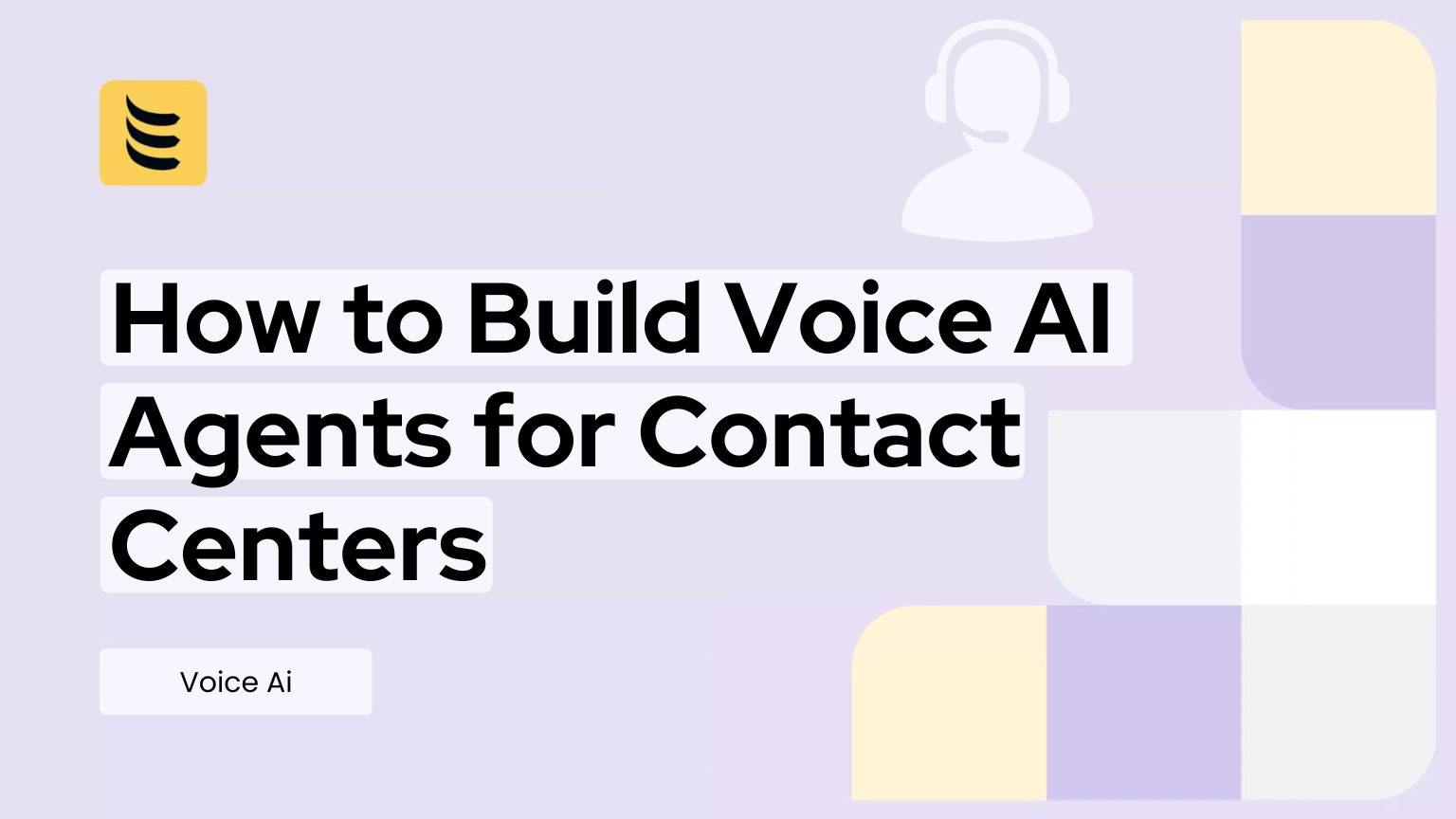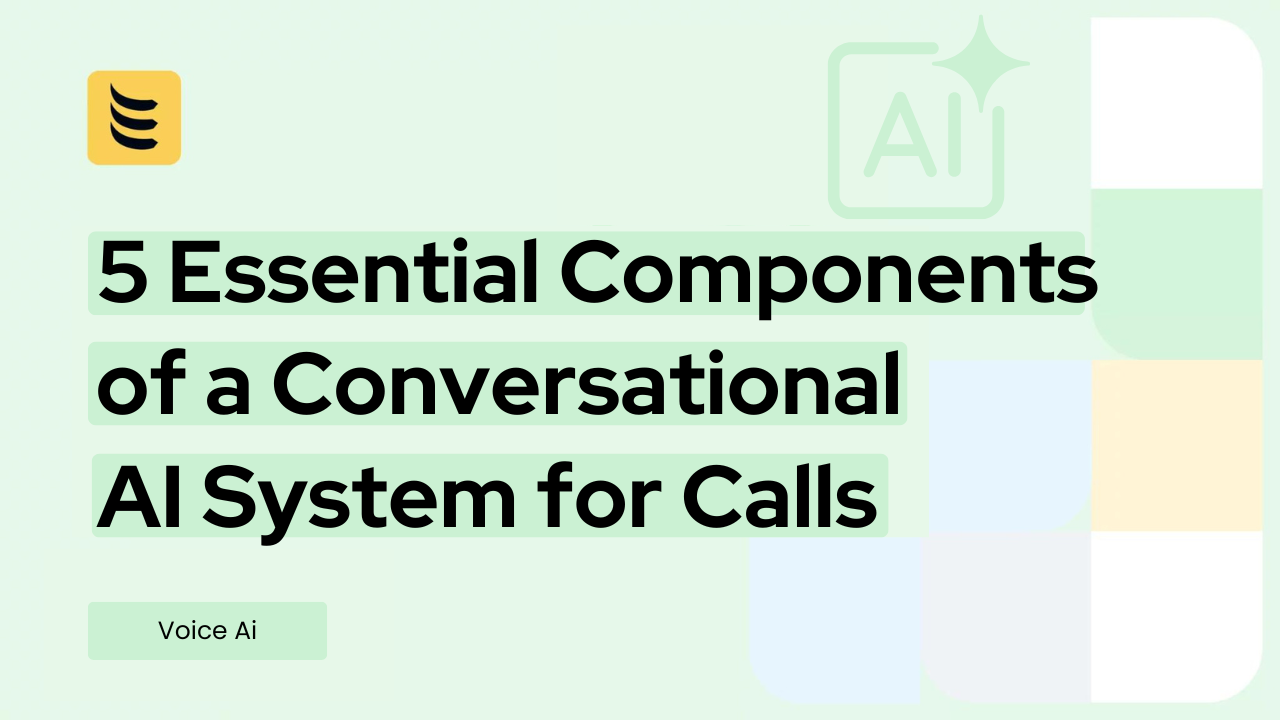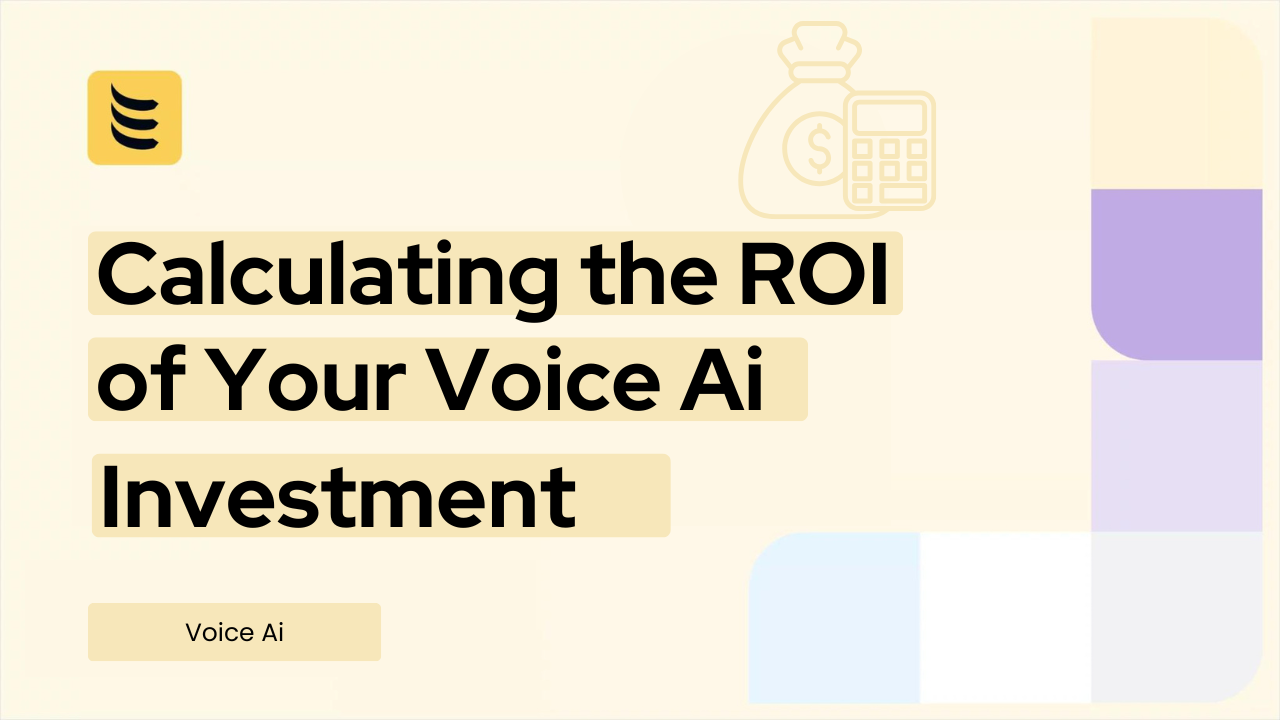1. The New Era of Voice Automation in Contact Centers
Think about the last time you called customer support. You probably wanted quick help, not a maze of menu options or long hold times. That’s exactly why many contact centers are now turning to voice automation. It helps customers get answers fast and takes pressure off human agents who can then focus on tougher cases.
Voice AI agents can do a lot of what people do on the phone. They can answer common questions, schedule appointments, share order updates, or collect feedback after a call. They don’t need breaks, work around the clock, and can handle many calls at once.
What makes them stand out from old IVR systems is how natural they sound. Instead of pressing 1 or 2, callers can just talk. The AI listens, understands what they mean, and responds like a real person. It makes the whole experience smoother and less frustrating.
For contact centers, that’s a big deal. It means fewer missed calls, shorter wait times, and happier customers. It also helps reduce costs without cutting back on service quality.
And unlike in the past, setting up this kind of technology isn’t hard anymore. Cloud-based tools make it possible to build and train a voice AI agent without months of coding or setup. Teams can test, tweak, and go live in days.
Voice automation isn’t just a new feature, it’s becoming part of everyday customer service. In the next sections, we’ll walk through how to build one step by step, from planning to launch.
2. Why Contact Centers Are Turning to Voice AI
Contact centers handle more calls than ever before. Customers expect quick answers and real conversations, not long waits or hold music. Meeting those expectations with human agents alone is hard and costly. That’s why more contact centers are turning to voice AI. It helps balance service quality with speed and cost.
Voice AI agents never get tired. They can handle hundreds of calls at once and stay polite every time. They don’t call in sick, need breaks, or forget what to say. For busy teams, that means fewer missed calls and shorter queues.
They’re also good at handling routine questions. Things like order status, account balance, or appointment details can be done instantly. When AI handles these, human agents get more time to solve complex or emotional issues, the ones that need empathy and judgment.
Another reason voice AI is catching on is accuracy. New systems understand speech better than older bots. They can recognize accents, catch intent, and respond naturally. This makes the caller feel heard, not brushed off by a robot.
For managers, the data is valuable too. Voice AI records, analyzes, and reports every call. That helps spot patterns, like why people call, what frustrates them, or which answers work best. It’s easier to make real improvements when you can see what’s happening in every interaction.
Costs are another factor. Hiring, training, and retaining large agent teams is expensive. Voice AI can handle many tasks for a fraction of the cost. It doesn’t replace people, it supports them by taking care of what machines do best: repetitive and fast responses.
Finally, customers like it. When the AI is built right, calls feel quick and natural. They get what they need without waiting or repeating themselves. That kind of experience keeps people coming back.
Voice AI isn’t just a nice extra anymore. It’s becoming a must-have tool for any contact center that wants to stay efficient and responsive. In the next section, we’ll see how to start building one that fits your needs.
3. Step 1: Define Your AI Agent’s Purpose and Use Cases
Before you start building, decide what your voice AI agent should do. Don’t try to make it handle everything at once. Pick clear, simple goals that match your contact center’s daily needs. A focused start helps your agent perform better from day one.
Look at where your team spends most of its time. Are agents answering the same basic questions again and again? Those are great starting points for automation. Tasks like checking order status, resetting passwords, confirming bookings, or sharing working hours can be handled by AI with ease.
Next, think about lead management. Voice AI agents can ask a few smart questions to qualify leads, collect details, and pass them to your sales team. This saves time and ensures only serious leads reach human agents.
Appointment scheduling is another easy win. The agent can book, confirm, or reschedule appointments without back-and-forth calls. The same goes for sending reminders or status updates. These small steps add up to big time savings.
Start small. Focus on high-volume, low-complexity calls first. These are calls that take up time but don’t need much human judgment. Once your agent handles these well, you can move to more complex interactions.
Think about your customers too. What kind of help do they need most often? Use real call data to find common topics or complaints. This helps you plan what your AI agent should learn first. The clearer the use cases, the smoother your setup will be.
A well-defined purpose keeps your project on track. It also makes it easier to measure success. You’ll know what “good” looks like, shorter calls, faster answers, or fewer missed calls.
With a platform like the IDT Express Voice AI Agent, you can quickly map intents to these use cases and train your agent using ready tools. You can go from idea to live agent in days, not months.
4. Step 2: Choose the Right Technology Stack
Once you know what your voice AI agent will do, it’s time to choose the right tools. The right technology stack makes sure your agent hears, understands, and responds clearly. Every part of this stack plays a key role in how natural and reliable your AI sounds.
Start with speech recognition, also called ASR (Automatic Speech Recognition). This is what lets the system hear spoken words and turn them into text. A good ASR engine can handle different accents, tones, and background noise. If this part fails, everything else breaks down. So, choose one with high accuracy and speed.
Next comes Natural Language Processing, or NLP. This is what helps your AI understand meaning, not just words. NLP looks at what the caller is trying to say, figures out intent, and decides the right response. A strong NLP engine can pick up small clues in speech, like tone or phrasing, that change the meaning of a request.
Then you need Text-to-Speech, or TTS. This converts text into spoken words. It’s what gives your AI its “voice.” A clear, natural TTS engine makes the agent sound human and easy to listen to. You can often choose between male or female voices, accents, and even tones that fit your brand style.
Another key part is voice routing and integration APIs. These connect your AI system to your phone lines, CRM, and ticketing software. With the right integration, your AI can pull customer data, update records, or send alerts to agents. It becomes part of your existing setup instead of a separate system.
Many companies now offer these tools already combined into one platform. That saves time and setup effort. Platforms like IDT Express, Twilio, and Google Dialogflow come pre-integrated with ASR, NLP, TTS, and API options. You don’t need to build or connect every layer yourself. You can focus on design, not backend work.
Integration is where most contact centers see the biggest benefits. When your AI agent connects with your CRM, IVR, or helpdesk tools, it can pull real-time data. For example, it can check a customer’s order before giving an update or open a support ticket while still on the call. That makes the whole system smarter and more useful.
Choosing the right stack sets the base for your AI project. Each part, ASR, NLP, TTS, and APIs—must work well together. A reliable platform that already brings these together, like IDT Express Voice AI, helps you skip long setup times and start building faster.
5. Step 3: Design Conversational Flows
Now that you have your tools in place, it’s time to plan how your AI agent will talk. This step shapes how every call feels for the customer. A well-planned flow makes conversations sound natural and keeps callers from getting stuck.
Start by mapping intents. An intent is what the caller wants to do—like check a balance, schedule a delivery, or reset a password. Each intent should lead to a clear response or action. Group similar intents together so your AI can handle them using one response pattern. This keeps your design simple and easy to manage.
Next, plan for fallbacks. No AI gets it right every time. When your system doesn’t understand a question, it should know what to say. A good fallback might be: “I didn’t get that. Would you like me to repeat the last step?” This keeps the caller engaged and avoids dead ends. Always design backup routes that return the user to a clear point in the conversation.
Tone matters too. Your AI should sound polite, patient, and easy to talk to. It shouldn’t feel robotic or rushed. Add small touches that feel human, pauses before key phrases, confirmation lines like “Got it” or “Let me check that for you,” and soft empathy when things go wrong. These details make a big difference in how people feel during the call.
Also think about context. If someone has already shared their order number, your AI shouldn’t ask again. Use stored information to keep the flow natural and smart. That’s how you make the conversation sound like it’s happening with a person, not a script.
Many platforms now include visual flow builders to make this step easier. These tools let you drag and drop boxes that represent intents, responses, and actions. Good conversational design is part logic and part empathy. You want your AI to handle questions clearly but still sound friendly. If people enjoy talking to your voice agent, they’ll trust it, and that trust is what makes automation work.
6. Step 4: Train and Test Your AI Agent
Once your voice AI agent is built, it needs training, just like a new employee. Good training helps the system understand real questions and respond the right way. Without it, even a strong design can fall apart when real callers start talking.
Start with training data. This is the information your AI uses to learn. Use real examples from your contact center, common questions, phrases, and even slang. The more real-world data you feed it, the better it performs. Make sure to include different accents, tones, and sentence styles so your AI doesn’t get confused when people speak in different ways.
AI training is not a one-time job. Keep feeding it new data from actual calls. Each new interaction helps it learn how people talk and what they expect. This process is called continuous learning. It keeps your system sharp and ready for new situations.
Before going live, run simulation tests. Let your team make test calls that cover every major use case. Try both normal and tricky questions. Listen to how the AI responds, and note where it hesitates or gives the wrong answer. Fix these gaps before real customers call in. Testing helps catch small errors that can frustrate users later.
Once your agent is live, keep an eye on key performance data. Track intent accuracy—how often the AI understands what the caller means. Measure call completion rates to see how many calls finish without needing a human handover. Review sentiment to learn how customers feel during each call. Many systems use tone and keywords to rate the emotion in a conversation.
All this data helps you spot weak areas and improve your AI over time. If intent accuracy drops, review the phrases linked to that intent. If completion rates fall, look at where callers hang up or ask for help. These signs tell you where the flow or training might need work.
Testing and training never stop. The best AI agents keep getting better every week. They learn from every call, every mistake, and every success, just like people do.
7. Step 5: Integrate, Deploy, and Monitor
Once your AI agent is trained and tested, it’s time to connect it to your live systems. This step turns your project into a working tool that can handle real customer calls. Integration is what lets your voice AI access information, trigger actions, and update records during a call.
Start with your CRM system. Connect your AI so it can pull customer names, order numbers, and account details. When the AI has this data, it can greet callers by name and give quick answers without asking for repeat details. This small step makes conversations feel personal and saves time.
Next, link your ticketing system or helpdesk. This lets your AI open, update, or close tickets automatically while talking to the customer. It helps agents too, when they step in, all the details are already recorded. It keeps everything organized without extra typing or switching screens.
Don’t forget your IVR or phone system. Your AI agent should fit into the existing call flow, not replace it entirely. Set clear rules for when calls go to the AI and when they should reach a human. For example, routine requests go to the AI first, while complex issues or escalations move to live agents. This balance gives callers a smooth and flexible experience.
After integration, start your deployment in small phases. Roll out to one department or region first. Monitor how the AI performs and fix any early issues. Once things run smoothly, you can expand to more lines or languages. Gradual deployment reduces risk and gives your team time to adjust.
Now comes the most important part, monitoring. Keep track of call success rates, response times, and handovers to humans. Watch for any patterns in where calls drop or where the AI struggles to respond. Check reports daily during the first few weeks.
The best voice AI systems include dashboards with live stats. You can see what’s happening on every call in real time. Platforms like IDT Express Voice AI, Amazon Connect, and Dialogflow CX offer these built-in tools. They make it easy to track performance and make quick updates without deep technical work.
Monitoring is not just about fixing problems. It’s also about finding ways to improve. Use feedback from agents and customers to update scripts, add intents, or change tone. Each small change brings your AI closer to a perfect fit for your contact center.
A well-integrated and carefully deployed voice AI agent becomes part of your team. It works quietly in the background, taking calls, updating systems, and helping customers get what they need faster.
8. Step 6: Scale and Optimize
Once your AI voice agent works well in one setup, it’s time to grow. Start by adding support for more languages and accents. This helps your agent reach new customers without losing clarity.
Next, expand coverage across time zones. Train and tune your models so they respond well to users at any hour. Use call data and feedback to spot weak points and improve responses.
Keep checking analytics to see what’s working and what’s not. Small updates over time can raise accuracy and cut handling time. Treat this as an ongoing cycle, test, learn, adjust, and repeat. That’s how you keep your AI voice agent sharp and ready for scale.
9. Common Mistakes to Avoid
Building a voice AI agent can go wrong if you skip the basics. Here are key mistakes to watch for.
1. Not setting clear KPIs before launch
You can’t improve what you don’t measure. Set clear goals from the start. Track metrics like call resolution, wait time, and customer satisfaction. Without them, you’ll never know if your agent works well or not.
2. Ignoring fallback design or escalation paths
AI agents can’t handle every case. Always design fallback paths to live agents or alternate channels. A smooth handoff keeps customers from feeling stuck or frustrated.
3. Overcomplicating early versions
Start simple. Focus on one or two use cases first. Add more tasks later as your system learns. A complex first release often breaks and confuses users.
4. Underestimating training data quality
The quality of your AI depends on the quality of your data. Use clear, diverse, and well-labeled samples. Poor data leads to poor responses, no matter how advanced your model is.
Good design, clear goals, and clean data are what separate effective voice AI agents from failed ones.
10. Conclusion: The Fast Track to AI-Driven Customer Experience
Building Voice AI Agents isn’t a complex task anymore. It’s a smart way to scale customer support, boost response speed, and cut costs. With the right tools, businesses can launch AI agents that sound natural and act with purpose.
Voice AI has moved beyond trial runs and pilot programs. It’s now a practical step for teams that want efficient, always-on service. What once took months of coding and setup can now be done in days with the right platform.
That’s where IDT Express Voice AI comes in. It gives you:
- Quick setup to start faster.
- Easy integration with your current systems.
- A reliable voice network built for clarity and uptime.
You get everything you need to build and run AI agents that handle calls naturally, route conversations smartly, and free up your team for higher-value work.
Ready to automate your contact center with natural-sounding AI agents?
Explore how IDT Express Voice AI can help you get started today.



